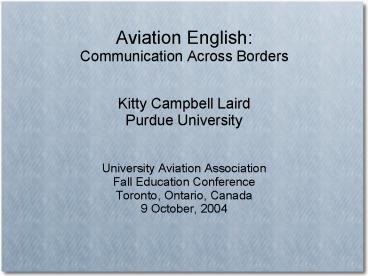Aviation English: Communication Across Borders - PowerPoint PPT Presentation
1 / 20
Title:
Aviation English: Communication Across Borders
Description:
Aviation English: Communication Across Borders. Kitty Campbell Laird. Purdue University ... English was not designated as an official language for aviation ... – PowerPoint PPT presentation
Number of Views:700
Avg rating:3.0/5.0
Title: Aviation English: Communication Across Borders
1
Aviation EnglishCommunication Across Borders
- Kitty Campbell Laird
- Purdue University
- University Aviation Association
- Fall Education Conference
- Toronto, Ontario, Canada
- 9 October, 2004
2
My Background
- Pilot
- Musician
- Sociolinguist
- ESL/EFL/ESP Instructor
3
Status of Aviation Communication
- radiotelephony limitations(analog/simplex)
- communication protocol(expected turns and
sequence) - restricted phraseology(purpose built vs. natural
language)
4
History of Aviation Communication
- English was not designated as an official
language for aviation communication - English-only was not mandated for aviation
communication on a global scale - English became the predominant lingua franca of
aviation - prescribed restricted phraseology of aviation
English was similar to maritime Seaspeak
5
Aviation Organizations
- International Civil Aviation Organization
(ICAO)(United Nations Organization with 188
Member States, promotes standards in civil
aviation) - Civil Aviation Authority (CAA)(each country's
regulatory agency, in the U.S. the Federal
Aviation Administration or FAA)
6
Major Language Related Accidents
- March 27, 1977 Tenerife (KLM/Pan Am)
- January 25, 1991 Cove Neck, NY (Avianca)
- December 20, 1997 Cali, Columbia (American)
7
Concerns with Current System
- need for minimum English proficiency beyond
restricted aviation phraseology - cultural awareness regarding differences in
varieties of English - complications in negotiation of meaning due to
regional local variation/accent dialect - special consideration of bilingual/multilingual
airspace due to lack of situational awareness
8
ICAO Initiatives
- use of fair reproducable phraseology
- rating scale for English proficiency
- holistic descriptors for language performance
- proposed implementation by 2008
- review of timeline feasibility in 2006
9
Aviation English Proficency Metrics(proposed,
but not yet established)
- ESP Aviation English test
- communicative competency test
- inter-rater reliability training
10
Technical System Improvements
- Controller/Pilot DataLink (CPDLC)
- real-time speech recognizer/translator
- FANS (Future Air Navigation System)
11
Current Technical Considerations
- Air Navigation Service (ANS)(under government or
private control) - Air Traffic Management (ATM) system(implementatio
n of standardized procedures) - Air Traffic Services (ATS)(dispatch
weather/airline, state, or private) - Airborne Collision Avoidance System
(ACAS)(conflict management)
12
ConclusionsAviation communication depends upon
- cooperation between aviation industry
regulatory entities - consensus in aviation communication and language
policies - wise implementation and standardization of
technology - global sensitivity to theinternational aviation
community
13
Discussion QuestionsWhat barriers does the U.S.
face to realistically implement the new ICAO
language policies?
- resistance to change from pilots/ATC
- different culture, chain of command, and unions
for pilots and ATC - FAA phraseology sometimes incompatible with ICAO
phraseology - plain English based on which variety of English
(undefined accent/dialect desired)
14
Discussion QuestionsWhat challenges does ICAO
face in assisting Member States to implement
new language policies?
- lack of standardization of training and testing
materials between Member States - Lack of resources for some Member States to
develop materials and/or comply with policies - Member States may have higher priorities for
available funding - commercial entities may not address needs
15
Discussion Questions
- Do the new holistic descriptors and ICAO language
proficiency scale offer good benchmarks for oral
English performance? - What audio samples are needed to operationalize
levels for stakeholders? - What types of training and testing materials will
be needed and what resources will be necessary to
produce these materials?
16
Discussion Questions
- Are there examples of other ICAO SARPs that lack
compliance or are ignored in practice? - Do Civil Aviation Athorities typically regulate
ICAO SARPs or do SARPs merely exist as guidelines
which go ignored unless non-compliance is called
into question?
17
Discussion Questions
- Is English-only for aviation communication the
best sollution for situational awareness? - Should a sterile cockpit be expanded to include
English-only communications? - In what instances might the use of more than one
language be beneficial in countries with
bilingual or multilingual airspace?
18
Discussion QuestionsHow will the success of
implementation of ICAO language policies impact
communication in other areas of the aviation
industry?
- maintenance
- flight attendants
- ramp personnel baggage handlers
- airline dispatch weather service providers
- ticketing agents customer service
19
Discussion QuestionsWhat can UAA do as
educators to help facilitate a smooth transition
during the implementation phase of new ICAO
language policies?
- encourage collaboration between countries and
aviation organizations - discourage resistance to change from the
aviation industry - promote discussion about resources and possible
sollutions
20
Questions or Comments?
- Kitty Campbell Laird
- Purdue University
- e-mail Kitty_at_Purdue.edu































